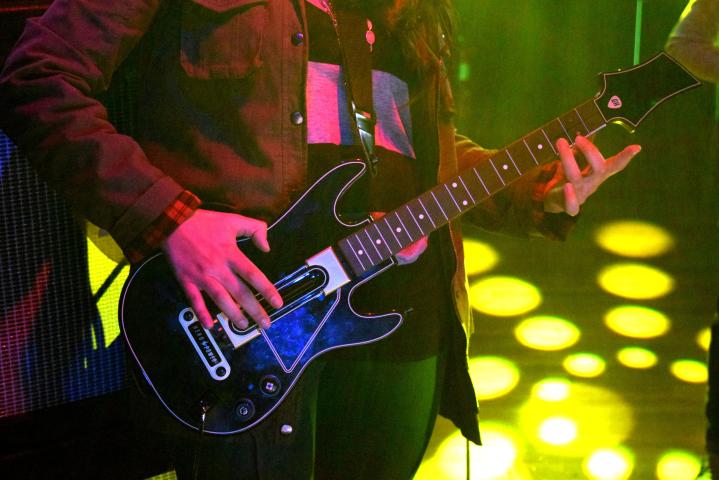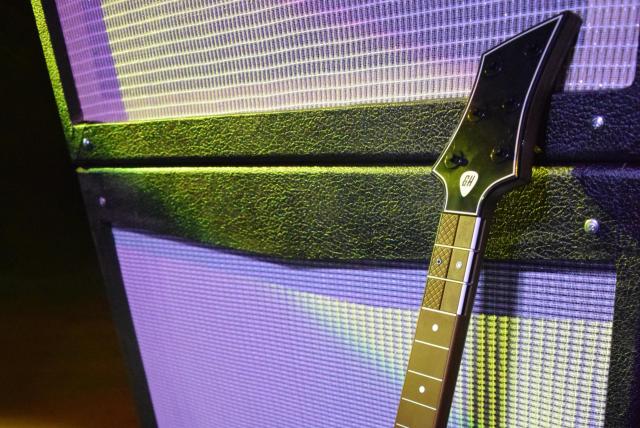
DJ Hero developer FreeStyleGames has taken up the series for Guitar Hero Live, coming in fall 2015 to PlayStation 3, PlayStation 4, Wii U, Xbox 360, Xbox One, phones, and tablets. The mobile version is particularly intriguing, as it promises to be identical to the console release, capable of hooking up to a TV or playing on the go. This will be the first entry in the series since 2010’s Guitar Hero: Warriors of Rock.
If video games are about fantasy fulfillment, then Guitar Hero’s appeal has always been for nonmusicians to feel like a rock star. In previous games, that experience was limited to the act of playing the plastic guitar in time with songs. The visuals that accompany the oncoming stream of notes to hit were from the audience perspective, showing your cartoon avatar rocking out in your place. The ethos of Guitar Hero Live is to focus on that fantasy, and build the entire experience around feeling like you’re on stage, playing in front of a live audience. Activision Publishing CEO Eric Hirshberg said that their starting question was whether the game could give you stage fright.

Songs are now played from a first-person perspective up on stage. The cartoon avatars are gone as well, replaced by live, filmed bandmates and audiences that respond dynamically to how you play. Before each song you start backstage, walking by technicians and groupies. A stern, bearded roadie places the guitar over your neck and gives you a nod of approval before you step on stage to face the crowd. The experience is much more immersive than previous games, down to details like a positional sound design that alters the mix based on where you wander on stage.
Each song was filmed live, so if you’re doing well then the crowd will be singing along. Miss a few too many notes, however, and the crowd will sour, booing and telling you exactly how much you suck. Your band is no less forgiving — as I completely lost my hand position during a chorus, I turned around to see the lead singer fuming and the drummer shooting daggers. Pay close attention to the video and the transitions between a happy and an unhappy crowd are pretty obvious, but as background it’s fantastic feedback.
Beyond just removing the cartoon characters, Guitar Hero Live‘s aesthetic is more elegant across the board. The multicolored buttons and fiery bursts have been replaced with clean graphics, mostly using black, white, and wood texture, like a classic Fender Stratocaster. The redesign extends beyond the in-game visuals and to the guitar controller itself, which is brand new for this edition of the game, though Hirshberg promised it will remain forward-compatible at least through the current console cycle.
It’s finally time to pick up that plastic guitar that’s been gathering dust next to your TV for the last few years and put it in the attic, because FreeStyleGames has redesigned the iconic controller with which Harmonix blew our minds for the PlayStation 2 original in 2005. The size, weight, and feel are familiar, but instead of five colorful buttons in a row, the neck boasts six wood-colored buttons in two rows of three. The goal of the redesign is to simultaneously lower the bar for entry while also raising the skill cap at the higher difficulties. Many people (the author, shamefully, included) choked in previous games at the addition of the fifth button and never progressed past Guitar Hero‘s medium difficulty. The new system aims to smooth out that curve from learning into high-level play. At the easiest level, only the bottom three buttons are used. Increasing the difficulty first adds in the top row, and then more complicated chord shapes that rely on both rows at once.

Guitar Hero Live also introduces a new gameplay mode, called Guitar Hero TV. It is a network of playable music videos from a wide variety of artists, divided into genre-specific channels. Compete for high scores against both friends and strangers, locally and online. Hundreds of songs will be available at launch, with the promise of more being continually added to the network over time. For the first time in a Guitar Hero or Rock Band game, players will be able to find new music to play, utilizing social media’s tools of sharing and discovery, without having to purchase expansion discs or download individual songs.
The developer did not reveal too much about what music would be available with the game at launch, since it is obviously still an ongoing process, but promised to support a wide range of genres. A few bands cited as already in the game are The Black Keys, My Chemical Romance, and Fall Out Boy, with the lead singers of the latter two making appearances at the reveal event to fumble through their own songs. More details about the game’s set list will no doubt emerge in the coming months leading up to the fall release.


